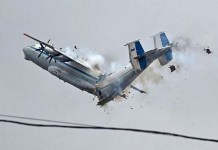The recent Turkish Airlines flight from Seattle to Istanbul had a shocking turn of events when Captain İlçehin Pehlivan, who was at the helm of the Airbus A350, collapsed and died mid-flight.
In what could be considered every passenger’s worst fear, the flight crew was suddenly faced with the unthinkable: what happens when the captain dies mid-flight?
Flight TK204, carrying passengers across the Atlantic, became the center of a tense situation as the crew had to make immediate decisions. Thanks to the rapid action of the co-pilot, who diverted the flight to New York’s JFK Airport, tragedy was limited to the unfortunate death of the captain.
The passengers, though shaken, were safely landed. The captain’s unexpected demise raised several questions about the procedures and the rigorous training that allows crews to manage such emergencies.
The Mid-Air Crisis
On October 9, 2024, the Turkish Airlines flight took off from Seattle as part of its routine long-haul route to Istanbul. Captain İlçehin Pehlivan, a seasoned pilot with over 17 years of experience, was in command.
After a few hours into the flight, the unexpected happened — the captain fainted mid-flight. Despite the crew’s best efforts to administer emergency medical treatment, Captain Pehlivan could not be revived and passed away before the plane could land.
With a plane full of passengers and the captain incapacitated, the flight’s co-pilot was forced to take over, steering the aircraft toward JFK International Airport, the nearest major airport. The flight safely landed in New York around 5:57 AM, with passengers later being transferred to continue their journey to Istanbul.
What Happens When A Pilot Dies In The Cockpit?
A situation like this prompts a critical question: what happens if a pilot, or in this case the captain, dies during a flight? The answer lies in the extensive training and strict aviation protocols that commercial pilots undergo.
Every commercial flight is operated with at least two qualified pilots in the cockpit: the captain and the co-pilot (also known as the first officer). Both pilots are fully trained and capable of flying the aircraft independently.
In the event of one pilot’s incapacitation, the other can assume full control of the plane. This redundancy is a crucial part of aviation safety protocols. On flight TK204, the co-pilot seamlessly took control of the Airbus A350, following established emergency procedures to ensure the safety of the passengers and crew.

The Immediate Response
When Captain Pehlivan collapsed, the flight crew acted swiftly, first attempting to revive him using onboard medical equipment.
Passengers with medical training were also called upon to assist, but unfortunately, their efforts were in vain. After recognizing that the captain’s condition was critical, the co-pilot and flight crew quickly made the decision to divert the plane to the nearest suitable airport, which was JFK in New York.
Diversions due to medical emergencies, while not uncommon, are a stressful and urgent situation for any flight crew. In this case, the co-pilot had the added burden of knowing that the captain, a colleague and friend, had tragically passed away.
Health Screening & Pilot Fitness
One of the major takeaways from this incident is the importance of pilot health screening. Captain Pehlivan had passed a rigorous medical examination in March 2024, which revealed no signs of illness or concerns that would have barred him from flying.
Aviation regulations in many countries require pilots to undergo regular medical exams to ensure they are fit to fly. These exams typically check for cardiovascular health, mental health, and other critical factors that could impact a pilot’s ability to safely operate an aircraft.
However, even with stringent medical checks, unforeseen medical conditions can arise, as seen in Captain Pehlivan’s case. This raises important questions about the effectiveness and frequency of pilot health evaluations, especially for those over a certain age.
The Psychological Toll On Crew & Passengers
The death of a captain mid-flight is not just a physical challenge for the remaining crew but also a psychological one. For the co-pilot, taking over the controls after witnessing the death of a colleague is an emotional burden, adding pressure to an already stressful situation.
The co-pilot’s ability to remain calm and focused under such distress is a testament to the intense training that pilots undergo.
For passengers, the situation could easily have led to panic. However, the professionalism of the flight crew likely played a significant role in maintaining calm on board.
Passengers were informed of the situation and reassured that the flight was under control. The safe landing at JFK helped mitigate what could have been a much more dangerous situation.
Historical Context: Previous Incidents
While rare, this is not the first time a pilot has died mid-flight. In 2014, an American Airlines captain passed away mid-flight, forcing the co-pilot to divert the plane.
In 2009, a Continental Airlines flight faced a similar scenario when the captain died of natural causes during a transatlantic flight from Brussels to Newark. In both cases, as with Turkish Airlines Flight TK204, the co-pilots were able to take over and safely land the aircraft.
These incidents, though few and far between, highlight the robust safety measures in place to ensure that even in the event of a captain’s incapacitation, flights can continue safely.
Moving Forward: Strengthening Protocols
In the wake of this tragedy, Turkish Airlines, along with aviation regulatory bodies, may review the health screening process for pilots. One possibility is introducing more frequent health checks for older pilots or pilots on long-haul routes, where fatigue and stress can exacerbate underlying conditions.
Airlines may also consider implementing additional onboard health monitoring systems to detect early signs of medical distress in pilots, potentially preventing future tragedies.
Another area of focus might be enhanced training for cabin crew and passengers on how to assist in medical emergencies, especially in cases involving the flight deck crew.
In Summary
The death of Captain İlçehin Pehlivan during Turkish Airlines Flight TK204 is a stark reminder of the unpredictable nature of life, even in highly controlled environments like commercial aviation.
The co-pilot’s swift action and the crew’s professionalism helped ensure that the passengers were brought to safety despite the tragic loss of the captain.
This incident also emphasizes the importance of ongoing discussions about pilot health, the effectiveness of medical screenings, and the resilience required by flight crews to handle emergencies.
As investigations continue, the aviation community will likely reflect on the lessons learned from this tragedy and continue to improve protocols to protect both passengers and crew in the future.
Though the captain’s life was tragically lost, the successful landing of the flight without further incident serves as a testament to the rigorous training, resilience, and preparedness of modern aviation professionals.
- Group Capt MJ Augustine Vinod VSM (R) is COO, AutoMicroUAS. The views expressed in the above piece are personal and solely those of the author. They do not necessarily reflect the EurAsian Times’ views.
- Vineet Maliakal contributed to the OPED.
- He tweets at @mjavinod




